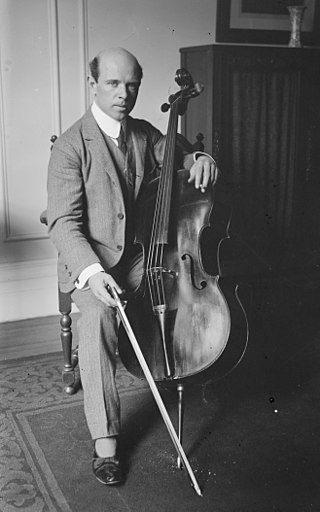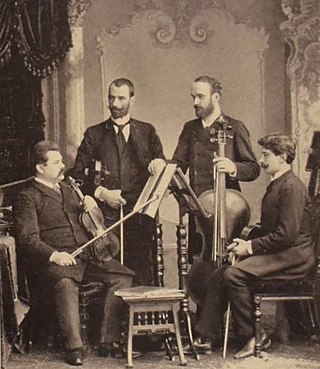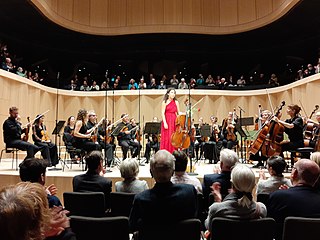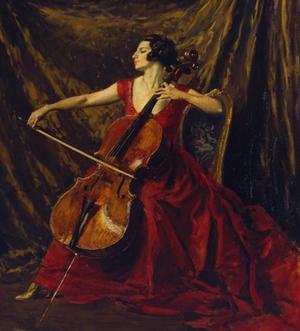
Pau Casals i Defilló, known in English as Pablo Casals, was a Catalan cellist, composer, and conductor. He made many recordings throughout his career of solo, chamber, and orchestral music, including some as conductor, but he is perhaps best remembered for the recordings he made of the Cello Suites by Bach. He was awarded the Presidential Medal of Freedom in 1963 by President John F. Kennedy.

Jacqueline Mary du Pré was a British cellist, widely regarded as one of the prominent cellists of the 20th century. Born in Oxford, she began studying at the Guildhall School of Music in the mid-1950s with William Pleeth, earning the school's Gold Medal in 1960. Her musical development was further enhanced by advanced studies with prominent cellists such as Paul Tortelier, Pablo Casals, and Mstislav Rostropovich.

Gregor Piatigorsky was a Russian Empire-born American cellist.

Truls Olaf Otterbech Mørk is a Norwegian cellist.

Julius Klengel was a German cellist who is most famous for his études and solo pieces written for the instrument. He was the brother of Paul Klengel. A member of the Gewandhausorchester of Leipzig at fifteen, he toured extensively throughout Europe as cellist and soloist of the Gewandhaus Quartet. His pupils include Guilhermina Suggia, Emanuel Feuermann, Gregor Piatigorsky and Alexandre Barjansky. See: List of music students by teacher: K to M#Julius Klengel.
Camille Saint-Saëns composed his Cello Concerto No. 1 in A minor, Op. 33, in 1872, when he was 37 years old. He wrote this work for the French cellist, viola da gamba player and instrument maker Auguste Tolbecque. Tolbecque was part of a distinguished family of musicians closely associated with the Société des Concerts du Conservatoire, France's leading concert society. The concerto was first performed on January 19, 1873, at the Paris Conservatoire concert with Tolbecque as soloist. This was considered a mark of Saint-Saëns' growing acceptance by the French musical establishment.

Emanuel Feuermann was an internationally celebrated cellist in the first half of the 20th century.
Daniel Müller-Schott is a German cellist.
William Pleeth OBE was a well-known British cellist and an eminent teacher, who became widely known as the teacher of Jacqueline du Pré.
Zara Nelsova was a prominent cellist.
Andrew Shulman is an English virtuoso cellist, conductor and composer. He is currently the principal cellist of the Los Angeles Chamber Orchestra and maintains his cello studio at the University of Southern California's Thornton School of Music in Los Angeles, California.

The Brodsky Quartet was a string quartet led by Adolph Brodsky. It was established on 1884, while Brodsky was professor at the Leipzig Conservatoire. The founding members, aside from Brodsky were Ottokar Nováček, Hans Sitt (viola) and Leopold Grützmacher (violoncello).

Amaryllis Marie-Louise Fleming was a British cello performer and teacher.
Kate Dillingham is an American classical cellist from New York City. She performs as a soloist and as a chamber musician, and is Artistic Director of the ArtsAhimsa Chamber Music Festival. A voting member of the Recording Academy (GRAMMY’s) and President of the Violoncello Society of New York (VCS), Dillingham made her debut with orchestra in Russia in 1998 with the Moscow Chamber Orchestra "The Seasons" and in Saint Petersburg with the St. Petersburg Philharmonic "Hermitage." In 2002, she made her New York debut recital at Merkin Concert Hall premiering a commissioned work by Augusta Read Thomas ("Chant") and premiered a solo work by Jennifer Higdon. Her recordings were licensed for use in the films La rafle and Les Berlinoises. A former student of Bernard Greenhouse, she is the Artistic Director of the Wellfleet CelloFest, held in honor of the centenary of his birth. Dillingham also studied with Maria Tchaikovskaya at the Moscow Conservatory. A teacher and inventor, she founded MyBlueSkiesMusic.com - an online teaching platform for musicians.

Lisa Barbier Cristiani, also known as Lise Cristiani or Elise Cristiani, was a French cellist and performer known for being one of the earliest recorded instances of a woman becoming a professional in the field.

Adriana de Vecchi was a Portuguese cellist, Montessori-trained educator and founder of a music school for children in Lisbon.
Harriet Krijgh is a Dutch cellist.
Florence Hooton was an English cellist, chamber music performer and teacher, responsible for many important British music premieres in the 1930s, 40s and 50s.

Ella van Poucke is a Dutch classical cellist. She has performed internationally as a soloist and chamber musician. From 2010, she has directed a chamber music festival in Amsterdam. Poucke has lectured at the Conservatorium van Amsterdam from September 2022.
Thelma Reiss was a British cellist who had an international career as a soloist and chamber musician between 1930 and 1955. Her teachers were Ivor James and Guilhermina Suggia. She was a musical prodigy from an impoverished background who toured in the south-west of England as a young child, and played in theatres, clubs and restaurants before coming to wider public attention in the early 1930s. In that decade she performed concertos with most major British orchestras, made several tours in Europe, and gave premieres of works by Arnold Bax and George Dyson, before her career was interrupted by the Second World War. After the war, she continued to give recitals, retiring from performance in 1955 due to ill health.











